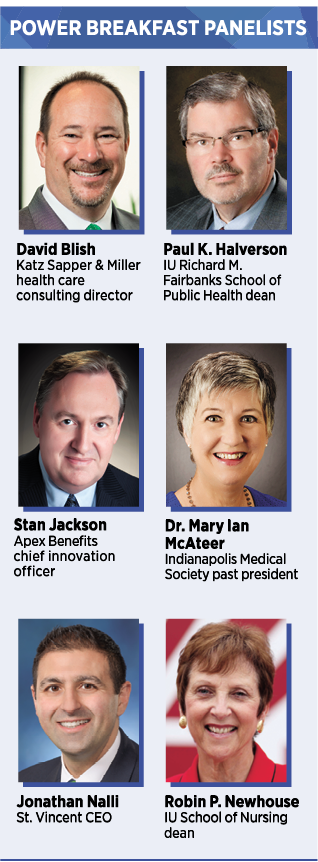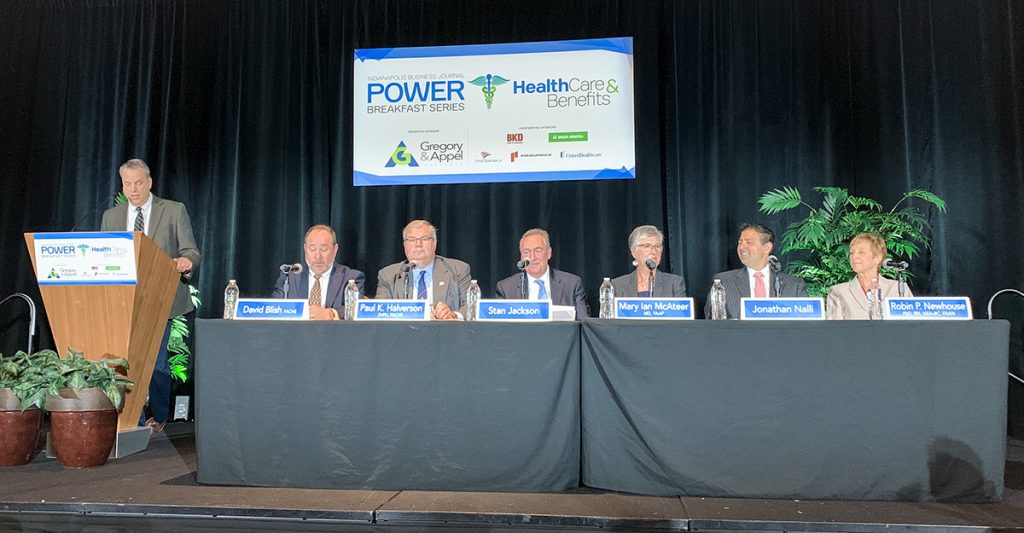Subscriber Benefit
As a subscriber you can listen to articles at work, in the car, or while you work out. Subscribe NowBelow are excerpts from the Sept. 26 Health Care & Benefits Power Breakfast.
Paul Halverson: If we look at the [Centers for Disease Control and Prevention] recommendations, they are essentially urging everyone to not vape. And in particular, the issue is an increasingly serious problem for us in Indiana. I think the latest numbers show that over 30% of seniors in high school vape. And if we look at the middle school rates, it is up close to 10%.
We also need to face the fact that we believe that there is a strong correlation between those people that vape and an increase in tobacco or combustible cigarettes.
So what started out as an idea of being an alternative is actually a gateway, especially for our kids.
 Dr. Mary Ann McAteer: Actually, in middle schools, the public restrooms are called the vape room, and that’s become off limits to children who don’t want to be exposed to those kinds of products. There are some reports on secondhand and third-degree harms, physical harms to the children, so I think parents need to be aware that that’s there.
Dr. Mary Ann McAteer: Actually, in middle schools, the public restrooms are called the vape room, and that’s become off limits to children who don’t want to be exposed to those kinds of products. There are some reports on secondhand and third-degree harms, physical harms to the children, so I think parents need to be aware that that’s there.
Robin Newhouse: When we think about the youth that are involved in vaping, more than half of the people that have gotten sick are younger than the age of 25. So it is an impending health problem. … We have decades of adverse effects that we could be seeing over the next 40 to 50 years for these children that are vaping.
Jonathan Nalli: What we have got to focus on as a society is that, if you look back on the initial cigarette ads—commercials, advertisements of 70, 80 years ago—and the glamorous aspect that was put out, we are experiencing this now in our time [with vaping]. And the heavier that we push against the exact dangers of this, known and unknown, the better off that we can thwart it.
Halverson: I suggest that the ultimate disruption [of health care] is actually turning our incentive system on its head. Ultimately, we know that, as long as you continue to incentivize more and higher-cost procedures, guess what you are going to get? More and higher-cost procedures.
And so the reality is that, until we change the incentive system so that providers are [rewarded] for keeping people healthy and we focus on prevention rather than catastrophic care in the last 90 days of life, we are really never going to get to the point where we actually can get our costs under control.
There are a whole lot of other issues, but in terms of disruption, we know that one way to reduce cost is to focus on keeping people well rather than simply treating them after the cow is already out of the barn, so to speak.
McAteer: I agree with the early intervention, but basically it starts at the physician/patient relationship, and that needs to be prioritized.
It could start with every single person in this room to reach out to their doctor and thank them for being available and then to start actually creating a relationship with their doctor.
Stan Jackson: As it relates to the deductible continuing to go up [on health insurance plans], the obvious part is, it saves money for the employer and the employees.
The disconnect many times in health care is, you have got 20% of your population using about 80% of your benefits. So the 80% of the people in the plan aren’t feeling that other than in the raises that they are getting in their premiums on a payroll-deduction basis.
But certainly when somebody has a care event or they are chronically ill, they are feeling that pinch.
David Blish: The HSA concept is great for controlling cost, but it may or may not be helpful in terms of getting people the right health care. Because if they have to pay for it from dollar one, they are more likely to skimp on it.
Now, having said that, many of the preventative services are covered at no cost.
So colonoscopies, mammography, immunizations—all of those are great investments.
Halverson: If you look at the 39 countries in the [Organisation for Economic Co-operation and Development], the developed countries, we have by far the highest contributions to health care as a percentage of our GDP and our results are among the worst in the world.
In some ways, the American way is, pay more and you get more. We pay more and we get less. In fact, substantially less.
Newhouse: Our response to [opioid] addiction started in October of 2017, and it is in partnership with the state and started out with two of the major health systems, IU Health and Eskenazi, but has now grown. We have over 144 partners now and our goals are to reduce deaths related to opioids, to decrease the number of people that have substance-use disorders, and to decrease the number of babies born that have been exposed to substances in utero—which were some of the major governor’s goals.
The studies aren’t done yet. … I would say that we are incredibly hopeful and we are seeing good signals. I haven’t seen the most recent data related to opioid deaths, but I understand that it is lower than the national average and that we should be seeing those significant results emerging soon.
Nalli: We still have no plans for [the 30 acres of undeveloped land St. Vincent bought at 96th and Spring Mill Road last year]. What we tell neighbors, what we tell businesses, is that any company that is looking to expand and grow and evolve, you have got to make sure that you have got the infrastructure to do that and that includes land and geographic expansion.
And so we did close on all of the parcels in and around our new corporate office at 96th and Spring Mill, and we are still going through what is the future state of health care for that property, for our 86th Street campus, Carmel and surrounding areas.
As health care innovates, we know that more is moving to the outpatient aspect of it. We are continuing to delve into virtual technology … and advancements in what we are doing.
So rather than be quick to move forward and say we are going to have a project, we are taking our time and being very thoughtful, because we don’t want to build something that won’t get utilized and spend precious dollars and capital resources to do that.
McAteer: [Physician burnout] is a huge problem. And, to review, physician burnout is defined as emotional exhaustion, a depersonalization where the physician looks at patients not as a fellow human being and doesn’t feel like the patient is also treating them as a fellow human being, and then a lack of self-worth.
It results in physicians leaving practices, and in toxic work environments. And we have a lot of data that says that patients who are under the care of a physician who is burned out or burning out, that they do not have good health outcomes, either.
The answer to that is to prioritize compassion and kindness in care, and that starts on a person-to-person basis.
Newhouse: I would say burnout is a big issue for nursing as well and the definition is certainly the same. And suicide is a big issue for nursing. It is hard to get the estimates for the United States, but for nursing it is about 19 per 100,000 persons and for physicians it is twice as bad.
We do know a lot more about what causes burnout for a nurse and for physicians, too. I mean, staffing is always an issue for both of us.
With nursing, we have looked at the shifts and how long a nurse can work, how many shifts during the week, how many hours, so we know that increased work time is associated with increased burnout.
We also know about the clinical environments where nurses are happier and comfortable. They are environments that have good engagement and decision-making, good nurse/physician collaboration and relationships, better quality of care.•
Please enable JavaScript to view this content.

